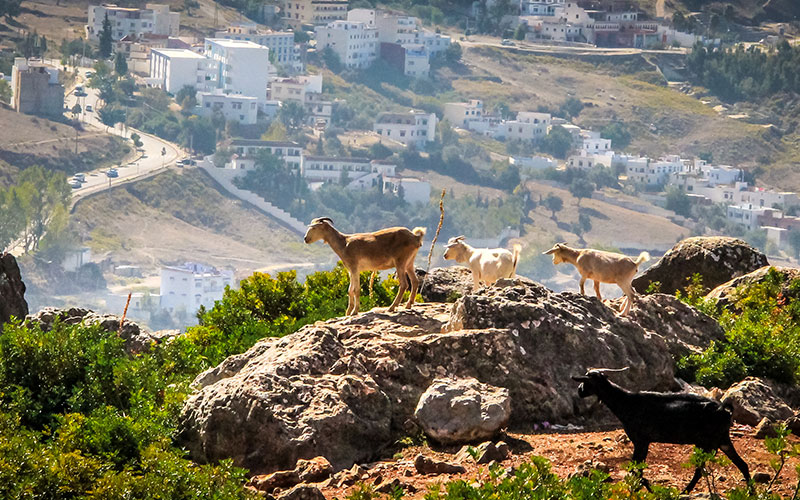Visiting Morocco in March: A Complete Guide
March is an excellent time to explore Morocco. This guide is your key to unlocking the secrets of a Moroccan adventure in March, providing valuable insights into the weather, packing essentials, must-visit destinations, and a host of memorable activities to elevate your journey to this captivating nation.
Weather in Morocco in March:

March in Morocco offers pleasant weather, making it an attractive time to visit. However, it’s essential to be prepared for regional variations in climate.
1- Coastal Areas (Casablanca, Rabat, Essaouira): Coastal regions experience mild temperatures ranging from 60°F (15°C) to 70°F (21°C). Expect occasional rainfall.
2- Marrakech and Inland Areas: Inland cities like Marrakech enjoy daytime highs around 70°F (21°C), but nights can still be chilly, dropping to around 50°F (10°C).
3- Sahara Desert: The Sahara Desert can be pretty hot during the day, with temperatures reaching 80°F (27°C) or higher. Nights are more relaxed but not uncomfortably cold.
Packing for Morocco in March:
When packing for Morocco in March, it’s crucial to consider the varying climates you might encounter. Here’s what you should include in your packing list:
– Lightweight clothing for daytime exploration.
– A sweater or light jacket for cooler evenings.
– Comfortable walking shoes for exploring cities and historical sites.
– Modest clothing for visiting mosques and religious sites.
– Sunscreen, sunglasses, and a wide-brimmed hat for protection against the sun.
– A universal power adapter for charging devices.
– A travel first aid kit and any necessary medications.
– A money belt or hidden pouch for securing valuables.
Best Places to Visit in Morocco in March:
Morocco boasts an abundance of captivating destinations, each radiating its distinct allure. Below, we unveil a selection of imperative places to explore during March:
1- Marrakech: Explore the vibrant markets of the Medina, visit the stunning Majorelle Garden, and experience the magic of Jemaa el-Fnaa Square.
2- Fes: Discover the ancient Medina of Fes, a UNESCO World Heritage site, and its historic monuments and bustling souks.
3- Chefchaouen: Known for its striking blue-painted buildings, this mountain town is perfect for hiking and relaxation.
4- Sahara Desert: Embark on a desert adventure, ride camels, and camp under the stars in a traditional Berber camp.
5- Essaouira: Enjoy the coastal charm of this picturesque town, known for its historic Medina and fresh seafood.
Things to Do in Morocco in March:
Morocco offers a wide range of activities in March:
10. Go Stargazing in the Moroccan Desert in March
End your Moroccan adventure on a celestial note by experiencing the Sahara Desert’s breathtaking night skies. Far from city lights, the desert offers a canvas of stars, where you can stargaze and marvel at the awe-inspiring beauty of the Milky Way, concluding your journey with a profound sense of wonder.
9. Visit Ait Ben Haddou near Ouarzazat in March
Venture into the cinematic landscape of Ait Ben Haddou, a UNESCO-listed ksar, or fortified village. Its unique architecture and desert surroundings have made it a sought-after location for numerous films and TV shows, offering a captivating blend of history and pop culture.
8. Have A Moroccan Tea Ceremony in March
Engage in an authentic Moroccan tea ceremony, a cherished ritual. Learn the intricate art of preparing mint tea, a symbol of hospitality in Morocco, and share conversations with locals over a cup, gaining deeper insights into their daily lives and traditions.
7. Discover Moroccan High Atlas Villages in March
Take a scenic road trip through the High Atlas Mountains, where you’ll encounter charming Berber villages nestled against dramatic mountain backdrops. Immerse yourself in the unique culture of these remote communities, each with its own story to tell.
6. Visit Historical Sites in Rabat in March
The capital city of Rabat boasts historical treasures. One is the Kasbah of the Udayas, a medieval fortress overlooking the Atlantic Ocean, and the Royal Palace, an architectural marvel that reflects Morocco’s regal past.
5. Visit The Coastal Town of Agadir in March
For a more laid-back experience, Agadir’s sandy beaches beckon. Relax by the ocean, engage in water sports, and indulge in the freshest seafood at picturesque seaside restaurants, offering a different perspective on Morocco’s coastal charm.
4. Gi Hiking in the Ourika Valley near Marrakesh in March
A day trip from bustling Marrakech, the Ourika Valley is a serene escape into nature. Discover lush landscapes, cascading waterfalls, and traditional Berber villages as you hike through this breathtaking valley, starkly contrasting the city’s hustle and bustle.
3. Visit Tanneries of Fez in March
Fez, known for its well-preserved ancient medina, offers a unique experience at its traditional tanneries. Take a guided tour to witness the intricate and age-old process of leather production, a craft deeply embedded in Morocco’s cultural fabric.
2. Visit Meknes and Its Palaces in March
A visit to Meknes, a city steeped in Moroccan royal history, is a journey back in time—Marvel at the luxury of Dar Jamai, a palace-turned-museum showcasing Moroccan craftsmanship. The Mausoleum of Moulay Ismail is another historical gem, offering insight into the country’s rich heritage.
1. Visit Historic Casablanca in March
Start your exploration in Casablanca, where modernity coexists seamlessly with history. The iconic Hassan II Mosque, one of the world’s largest mosques, is a must-visit. Its stunning architecture and oceanside location create a mesmerizing backdrop for your visit.






